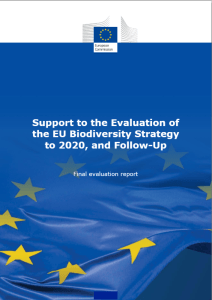The Council reached an agreement on the nature restoration law. The proposal aims to put in place recovery measures that will cover at least 20 % of the EU’s land and 20 % sea areas by 2030, and all ecosystems in need of restoration by 2050.

The general approach will serve as a mandate for negotiations with the European Parliament on the final shape of the legislation.
The Council’s text sets a balance between keeping ambitious goals for nature restoration and providing flexibility for member states in the implementation of the regulation, while keeping a level-playing field and reducing administrative burden.
Restoration obligations
The Council agreed that member states would put in place restoration measures that bring at least 30% of habitats in terrestrial, coastal, freshwater and marine ecosystems that are not in good condition, into good condition by 2030. This would apply to at least 30% of the total area of the habitat types that are deemed not in good condition, as opposed to the area for each habitat group, as initially proposed by the Commission.
Member states would however set restoration measures on at least 60% by 2040 and on at least 90 % by 2050 of the area of each habitat group that is not in good condition.
Member states added an exception for marine areas that have soft sediment habitats. For soft sediments, member states will be able to apply a lower percentage for the targets and the 2030 target would not apply.
Non-deterioration requirement
For areas of habitats subject to restoration measures, member states agreed they would ensure that significant deterioration does not occur. In areas already in good condition or where restoration measures are not yet implemented, particularly outside the Natura 2000 network of protected areas, member states would endeavour to put in place necessary measures to prevent significant deterioration. This would translate into a results-based obligation for the former and an effort-based obligation for the latter.
Knowledge gaps
Member states concurred that there is a lack of data about the condition of some habitats and therefore it is difficult to quantify their improvement.
Member states agreed that quantitative restoration measures would only apply to areas where the condition of habitats is known.
For terrestrial habitats, member states would have until 2030 to determine 90% of the condition of the habitats. For marine habitats 50% of the knowledge gaps would have to be closed by 2030. The condition of all habitats would need to be known by 2040, except for soft sediment where the deadline is extended to 2050.

Horizon Europe: Testing and demonstrating transformative solutions increasing climate resilience of the agriculture and/or forestry sector
|
Ecosystem-specific obligations
The proposal contains obligations that are specific to ecosystems, to which the Council brought various flexibilities.
For instance, for urban ecosystems, the Council replaced quantitative targets with an obligation for member states to achieve an increasing trend in urban green areas until a satisfactory level is reached. The Council kept the ‘no net loss’ requirement, which provides that no net loss of urban green space and of urban tree canopy cover should occur by 2030, compared to when the regulation enters into force, unless urban ecosystems already have over 45% of green space.
The Council softened the targets for rewetting of peatlands, to take account of the fact that some member states are disproportionately impacted by these obligations. The Council set to restore 30% of drained peatlands under agricultural use by 2030 and 50% by 2050, with the possibility for member states that are heavily affected to apply a lower percentage.
The Council provided more flexibility in the use of indicators to monitor forest ecosystems.
For high-diversity landscape features in agricultural ecosystems, like hedges, tree rows, patches, ditches, ponds or fruit trees, the Council added the possibility to focus measures on those that are necessary for the preservation of biodiversity.
The Council added an obligation for member states to ensure that restored river connectivity should be maintained.
National restoration plans
Under the new rules member states would regularly submit national restoration plans to the Commission showing how they will deliver on the targets. They would also monitor and report on their progress.
The Council opted for a stepwise approach. Instead of submitting full plans until 2050 two years after the entry into force of the regulation, member states would first submit national restoration plans covering the period until June 2032, with a strategic overview for the period beyond June 2032. By June 2032 member states would submit restoration plans until 2042 with a strategic overview until 2050 and by June 2042 they would submit plans until 2050.
The Council added the possibility for member states to take into account specific national varieties in terms of social, economic and cultural requirements, regional and local characteristics and population density, including the specific situation of outermost regions, in their plans.
The Council harmonised as far possible, the monitoring and reporting cycles with existing reporting cycles in other environmental legislation, in order to add coherence.
Renewable energies and defence
The Council added a new article providing that the planning, construction and operation of plants for the production of energy from renewable sources, their connection to the grid and the related grid itself and storage assets, are presumed to have an overriding public interest.
This means that they would benefit from a derogation to the obligations of continuous improvement and non-deterioration. In addition, member states would be able to exempt these projects from the obligation to demonstrate that less damaging alternative solutions are available, if a strategic environmental assessment has been carried out. To secure the alignment with the renewable energy directive, currently under revision, member states may also restrict in the application of these exemptions in accordance with the priorities set in their national integrated energy and climate plans.

Support to the Evaluation of the EU biodiversity strategy to 2020, and follow-up. Final evaluation report
|
The Council also clarified that plans and projects for the sole purpose of national defence can be presumed as having an overriding public interest and may be exempted from the requirement that no less damaging alternative solutions are available. However, member states should put in place measures to mitigate the impacts on the habitat types where they apply this exemption.
Financing restoration measures
The Council introduced a new provision asking the Commission to submit a report, one year after the entry into force of the regulation, with an overview of financial resources available at EU level, an assessment of the funding needs for implementation, and an analysis to identify any funding gaps. The report would also include adequate proposals, where appropriate, and without prejudging the next multiannual financial framework (2028-2034).
Next steps
The general approach will serve as the Council’s mandate for negotiations with the European Parliament on the final shape of the legislation. The outcome of the negotiations would have to be formally adopted by the Council and the Parliament.
More information: Council of the EU






Leave a Reply